SymRoll troubleshooting - leakage, cover wear and vibration
Jan 19, 2021
For troublefree function of SymRolls, the following are troubleshooting and maintenance tips and procedures regarding oil leakage, hydraulic and pneumatic systems, roll cover wear, roll vibration and other roll change factors.
Troubleshooting
If the required differential pressure is not reached with the given values, troubleshooting shall be carried out according to the following block diagram.
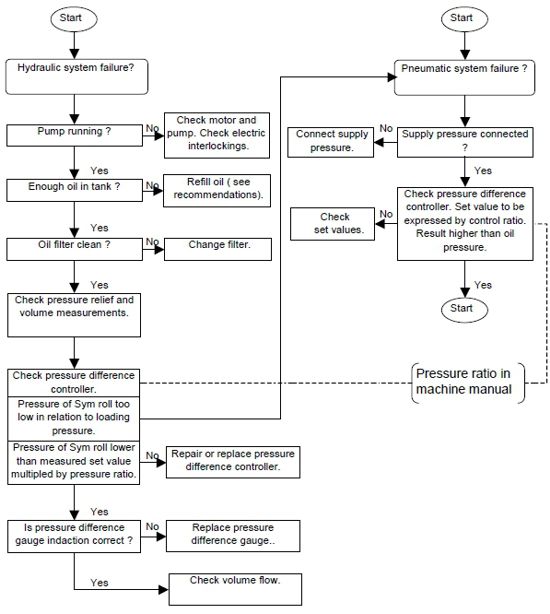
Block diagram for troubleshooting system failures
The amount of leak oil must be measured to find out whether the axial and end seals leak properly with the given settings.
Testing of leakage (static leak test)
- Release the differential pressure regulator from the end of the roll.
- Plug the line of the non-pressurized chamber.
- Reconnect the differential pressure regulator.
- Install a rotameter equipped with a throttle valve and discharge valve between the roll and the pressure hose.
- Start the hydraulic pump and increase oil flow to the roll slowly until the required internal differential pressure is obtained in the pressurized chamber. The pressure is measured from the regulator with separate pressure gauge. The test pressure in a static test is normally 0.2 MPa. If the greatest allowable differential pressure is smaller then 0.2 MPa, this pressure is the test pressure in the static test.
- Compare the result to the average amount of oil leakage shown in the following graphs. The deviation can be 20% or 10 l/min.
- Stop the hydraulic pump, open the dischage valve and dismount the rotameter with valves. Dismount the differential pressure regulator and remove the plugs.
- Install the differential pressure regulator.
- Reinstall the normal connections.
- The roll is ready for normal operation.
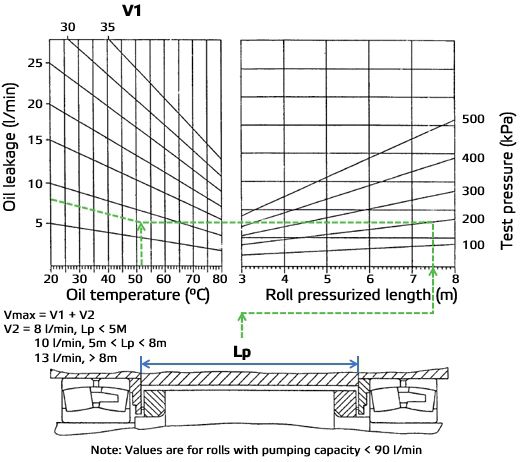
Average/Maximum oil leakage on SymRolls
Roll cover wear
The roll cover wears across the sheet width. When the cover is worn to a certain extent, the edges outside the sheet area start to carry the load in the nip. The figure below shows the profile of a worn roll. The shell end surfaces are 0.25 mm higher than the worn sheet area.
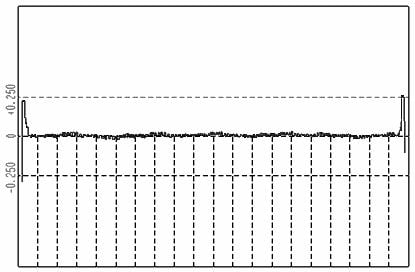
Profile of worn roll
Worn roll ends may be indicated by an increased profiling need in the edge areas, dry edges of the felt moisture profile and wet edges of the sheet moisture profile. The felt may also start to wear out and become more compact in the edge areas, which results in picking of sheet edges and loose sheet edges at the beginning of the dryer section.
Roll vibration
As a result of vibration the roll wears unevenly, producing a wavy shell profile in the source of time.
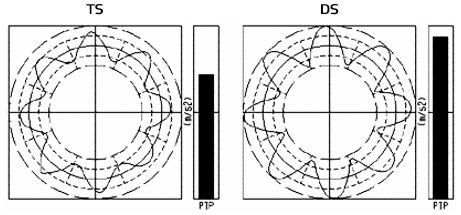
Vibration measured from a roll worn to a wavy shape
The wavy shape can be observed as an increased vibration level synchronous to the roll. The figure below shows the vibration level as a function of time. At point 1, the vibration level has exceeded a given monitoring level, due to which the roll has been changed for the first time. At point 2, the roll must be changed again.
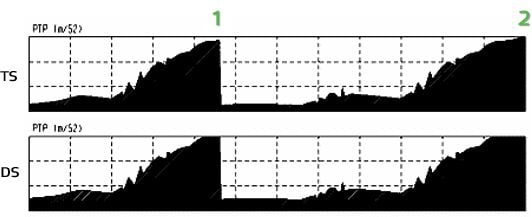
Vibration level of roll as function of time
Directive limit values for vibration levels of press rolls
In calender positions, problems may be caused by even lower vibration levels in practice.
A rise in the vibration level may be due to other factors than shell wear as well, such as roll gear, bearing failure, misalignment of universal shaft or beaten press felt.
Vibration level measured from bearing pedestal and shaft
- Good vibration level: Vrms= 1.5 mm/s
- Satisfactory vibration level: 1.5 mm/s < Vrms < 2.0 mm/s
- Roll must be changed during next shutdown: 2.0 mm/s < Vrms < 2.5 mm/s
- Roll must be changed: V rms < 2.5 mm/s
Other factors requiring roll change
Unusually quick plugging of filters in the Sym Roll hydraulic center may be due to plugged breather filters, addition of impure oil in the system and the resulting corrosion and deposit formation.
However, if the above reasons can be excluded, the plugging is probably caused by wear particles coming off from the roll. This phenomenon is extremely rare and it is probably indicated by an increased drive power requirement and/or a peak in the shell surface temperature profile. In such a case, the roll must be changed and opened to find out the cause.
If water has entered the system, attempts must be made to eliminate the water by separation during running. If the roll is removed while in water ballast, it must be opened without delay to avoid corrosion damage to the shell.
For more information on maintaining your rolls, contact your Valmet representative.